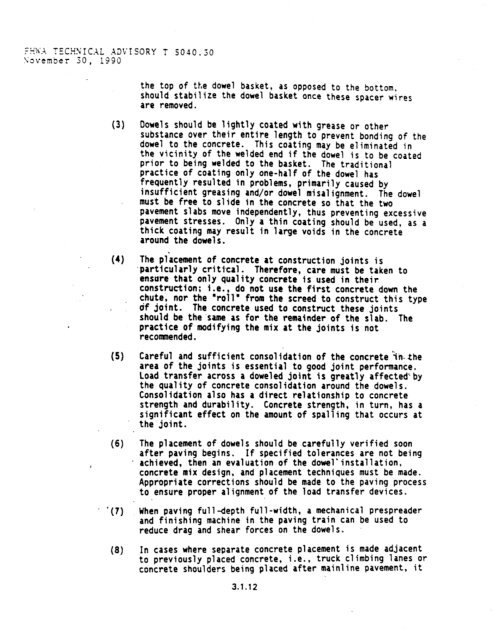chapter 3 rigid pavement - DOT On-Line Publications - Department ...
chapter 3 rigid pavement - DOT On-Line Publications - Department ...
chapter 3 rigid pavement - DOT On-Line Publications - Department ...
You also want an ePaper? Increase the reach of your titles
YUMPU automatically turns print PDFs into web optimized ePapers that Google loves.
. C ‘i!\‘*A . . T’ECHSIC4L .UV?SORY T 5040.30<br />
November 30, 1990<br />
,<br />
the top of the dowel basket, as opposed to the bottom,<br />
should stabilize the dowel basket once these spacer wires<br />
are removed.<br />
(3) Dowels should be lightly coated with grease or other<br />
substance over their entire length to prevent bonding of the<br />
dowel to the concrete. This coating may be eliminated in<br />
the vicinity of the welded end if the dowel is to be coated<br />
prior to being welded to the basket. The traditional<br />
practice of coating only one-half of the dowel has<br />
frequently resulted in problems, primarily caused by<br />
insufficient greasing and/or dowel misalignment. The dowel<br />
must be free to slide in the concrete so that the two<br />
<strong>pavement</strong> slabs move independently, thus preventing excessive<br />
<strong>pavement</strong> stresses. <strong>On</strong>ly a thin coating should be used, as a<br />
thick coating may result in large voids in the concrete<br />
around the dowels.<br />
(4) The placement of concrete at construction joints is<br />
.particularly critical. Therefore, care must be taken to<br />
ensure that only quality concrete is used in their<br />
construction; i.e., do not use the first concrete down the<br />
chute, nor the "roll" from the screed to construct this type<br />
if joint. The concrete used to construct these joints<br />
should be the'same as for the remainder of the slab.<br />
practice of modifying the mix at the jo i nts is not<br />
recommended.<br />
The<br />
(5) Careful and sufficient consolidation of the concrete $&the<br />
area of the joints is essential to good joint performance.<br />
Load transfer across a doweled joint is greatly affected'by<br />
the quality of concrete consolidation around the dowels.<br />
Consolidation also has a direct relationship to concrete<br />
strength and durability. Concrete strength, in turn, has a<br />
significant effect on the amount of spalling that occurs at<br />
the joint.<br />
(6) The placement of.dowels should be-carefully verified soon<br />
after paving begins. If specified tolerances are not being<br />
t . achieved, then an evaluation of the dowel'installation,<br />
concrete mix design, and placement techniques must be made.<br />
Appropriate corrections should be made to the paving process<br />
to ensure proper alignment of the load transfer devices.<br />
. '(7) When paving fulldepth full-width, a mechanical prespreader<br />
and finishing machine in the paving train can be used to<br />
reduce drag and shear forces on the dowels.<br />
(81 In cases where separate concrete placement is made adjacent<br />
to previously placed concrete, i.e., truck climbing lanes or<br />
concrete shoulders being placed after mainline <strong>pavement</strong>, it<br />
3.1.12
















